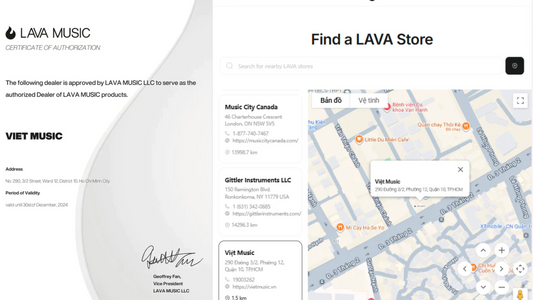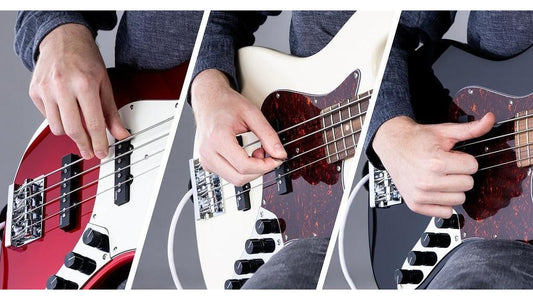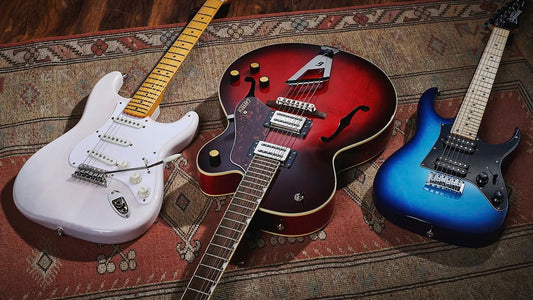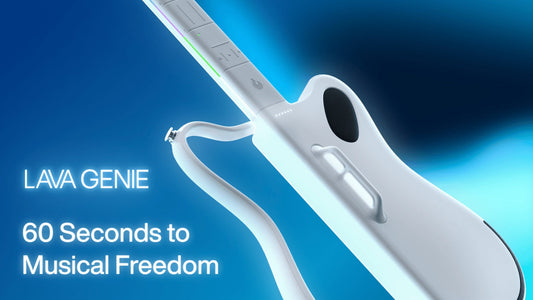
Hướng Dẫn Mua Dây Đàn Guitar
Chọn mua dây đàn là một quá trình quan trọng để đạt được âm thanh tốt nhất từ cây đàn của bạn. Dây đàn là một phần thiết yếu của cây đàn guitar, vì chúng tác động trực tiếp để tạo ra âm thanh khi bạn chơi. Để giúp bạn chọn được dây đàn phù hợp, dưới đây là một số hướng dẫn cách mua dây đàn.
Acoustic - Dây sắt.
Nếu dây từ dây thứ 3 đến dây thứ 6 của bạn có màu vàng hoặc nâu và hai dây trên cùng bằng thép, thì có khả năng bạn đang sở hữu một cây đàn guitar acoustic, còn được gọi là dây sắt. Tuy nhiên, nếu bạn không hoàn toàn chắc chắn và nghĩ rằng đó là cây đàn guitar cổ điển thì hãy nhanh chóng nới lỏng dây đàn và mang đến cửa hàng gần nhà, họ sẽ giúp bạn xác định. Đàn guitar acoustic “dây sắt” được sử dụng bằng dây đồng phốt pho hoặc dây đồng 80/20. Còn nhiều loại chất khác, nhưng hai loại này là phổ biến nhất.

Đồng 80/20.
Đồng 80/20 là loại hợp kim dùng để làm dây đàn guitar acoustic, được làm từ 80% đồng và 20% thiếc. Loại dây này thường có màu sáng, âm thanh ấm áp, tươi sáng, chúng có độ bền cao và độ ổn định âm thanh tốt sau thời gian sử dụng. Dây đồng 80/20 thường rẻ hơn hoặc bằng giá với đồng phốt pho, được sản xuất bởi hầu hết các nhà sản xuất dây.
Đồng phốt-pho.
Loại dây này có màu sẫm hơn (vàng mật ong đậm hơn) và âm sắc tối hơn, dây đồng phốt-pho tạo ra âm sắc đậm, ấm, phong phú, sống động. Mặc dù chúng sử dụng cùng loại dây 80/20 nhưng chúng thường đặt nhiều áp lực hơn lên cây đàn guitar, do đó tạo ra một giai điệu phóng khoáng hơn.
Dây đàn guitar điện.
Việc chọn dây cho guitar điện khá đơn giản, tuy nhiên có một vài yếu tố bạn cần quan tâm. Ví dụ cây đàn guitar của bạn có hệ thống tremolo hay không? Các dây đi qua thân đàn hay qua đuôi của guiatr? Bạn hiện đang chơi cỡ dây nào? Những câu hỏi này đóng vai trò quan trọng trong quá trình chọn dây đàn guitar điện. Dây đàn guitar điện được làm từ nhiều hợp kim khác nhau, kỹ thuật lên dây khác nhau, chúng đa dạng về kích cỡ. Vậy làm thế nào để bạn chọn được dây phù hợp?

Kích cỡ
Đầu tiên bạn nên nhìn vào kích thước của dây. Ngay cả những cửa hàng lớn không thể bán mọi nhãn hiệu, kích cỡ và hình dạng của dây trên thị trường. Họ có thể chỉ có một vài nhãn hiệu có kích thước phù hợp, vì vậy hãy chọn kích thước dây trước, sau đó tiếp tục.
Kích thước dây thường được gọi bằng đường kính của dây nhỏ nhất, hoặc trong một số trường hợp là đường kính của dây nhỏ nhất và dây dày nhất (dây cỡ 10 hoặc “10-52”).
Dây cỡ 7 và 8 - nhiều cửa hàng có thể không có sẵn dây cỡ 7, dây cỡ 7 và 8 cực kỳ nhẹ, tuy nhiên không phải người chơi nào cũng thấy đủ âm thanh và độ bền. Ưu điểm đáng chú ý nhất của dây cỡ 7 hoặc 8 là cảm giác nhẹ và dễ uốn cong.
Cỡ 9 - là loại dây phổ biến nhất, được sử dụng trên nhiều loại như Ghi-ta Fender, ghi-ta có hệ thống tremolo Floyd Rose và nhiều loại khác. Đối với người chơi đang tìm kiếm một dây có cảm giác nhẹ và dễ uốn cong, dây cỡ 9 là lựa chọn đáng xem.
Dây cỡ 10 - hầu hết các cây đàn guitar có đuôi đàn, dây đi qua thân đàn và nhiều loại khác sẽ sử dụng dây cỡ 10. Dây số 10 nặng hơn một chút so với cỡ 9, nhưng lại đem lại giai điệu và độ bền tốt hơn.
11, 12, 13 và hơn thế nữa- Các dây nặng hơn này phục vụ cho nhiều mục đích, phổ biến nhất là tạo ra nhiều giai điệu hơn và độ bền cao cho những người chơi như huyền thoại nhạc blues Stevie Ray Vaughn, đồng thời bù đắp cho độ căng bị mất khi điều chỉnh giảm thường thấy trong rock, grunge và kim loại. Thông thường, cây đàn guitar của bạn sẽ cần một số điều chỉnh để giữ nó ở tình trạng chơi tối ưu.
Trong số đó, dây thép mạ niken là loại phổ biến nhất, nhiều công ty sản xuất còn thêm các vật liệu như Combalt, Titanium và các loại hỗn hợp. Bạn có thể nghiên cứu và lựa chọn loại dây phù hợp, hoặc đơn giản chỉ cần thử từng loại để xem loại nào phù hợp nhất với cây đàn của bạn.
Dây được phủ bề mặt và loại không phủ.
Cả dây điện và dây acoustic đều có thể được “phủ” hoặc “không phủ” (trơn). Dây được phủ sẽ có một lớp vật liệu chống ăn mòn bảo vệ. Dây được phủ thường sẽ kéo dài tuổi thọ và là lựa chọn tuyệt vời cho những người chơi thường xuyên bị ra mồ hôi tay. Dây được phủ có thể âm thanh ban đầu không được sôi nổi nhưng về lâu dàu âm thanh sẽ được duy trì ổn định hơn.
Classic - Cổ điển.
Lựa chọn cuối cùng là một cây đàn guitar cổ điển, có các dây thứ 4, 5 ,6 (D, A, E), thường bị nhầm với dây sắt, nhưng thực ra chúng có dây lụa chạy bên trong, giúp dây chơi mượt mà và cực kỳ linh hoạt. 3 dây trên cùng thường là nylon trong suốt, nhưng đôi khi sẽ có màu trắng, đen hoặc một số màu khác.
Những cây đàn này cần được lắp bằng dây nylon để đạt hiệu suất tốt nhất. Việc lắp dây điện hoặc dây acoustic có thể sẽ khiến cây đàn bị hư hỏng nghiêm trọng.

Dây đàn guitar cổ điển được làm từ nhiều loại vật liệu và hỗn hợp khác nhau, độ căng từ thấp đến cao. Cũng giống như acoustic và điện, độ căng cao hơn có nghĩa là khó chơi hơn, nhưng lại mang âm sắc và độ ngân tốt hơn. Ngược lại, độ căng thấp hơn sẽ dễ chơi hơn nhưng ít âm sắc và độ ngân hơn.












